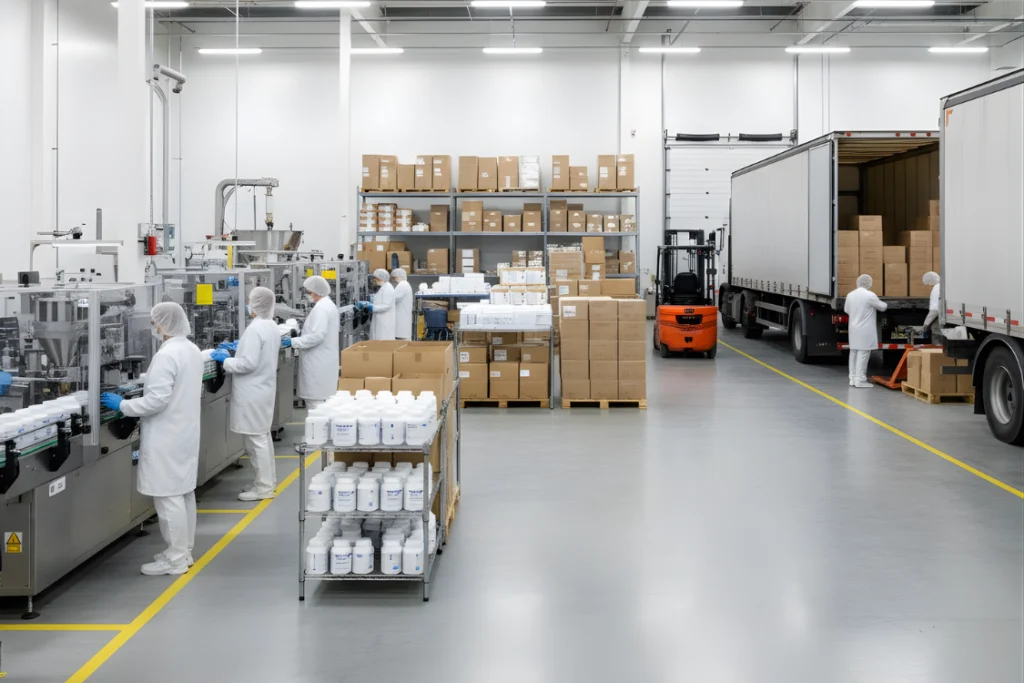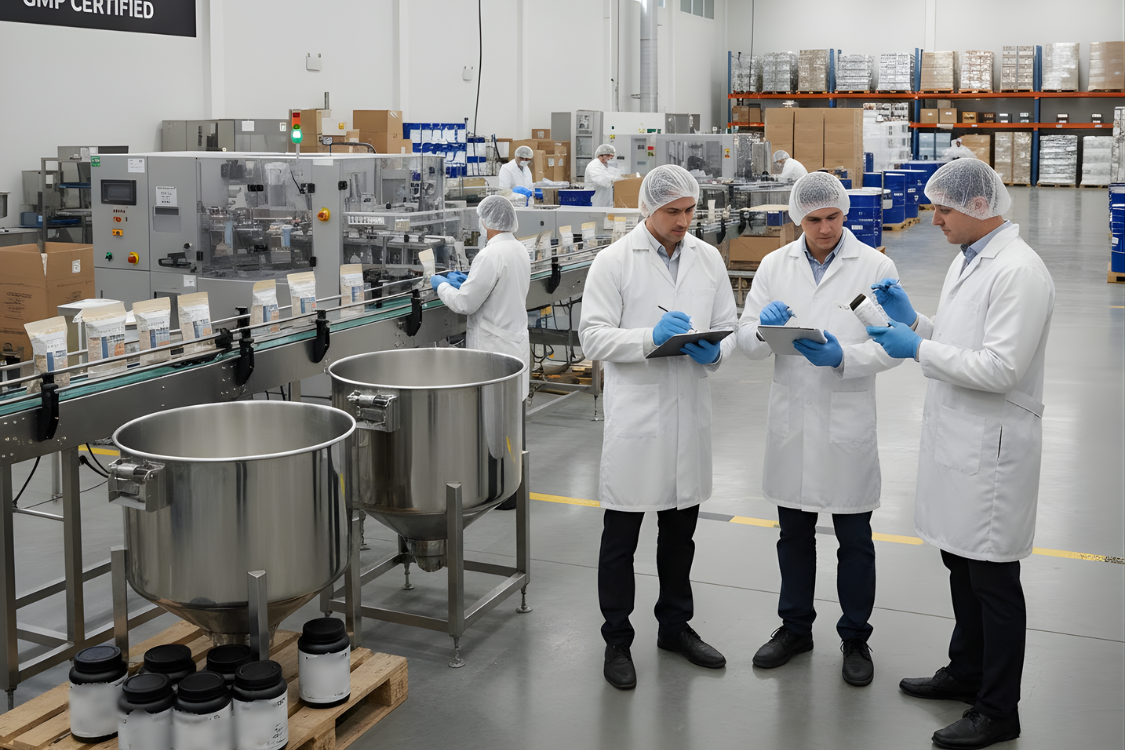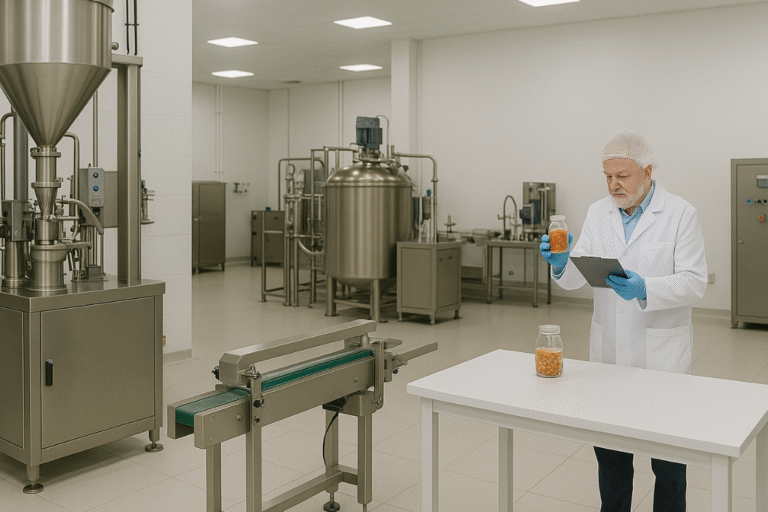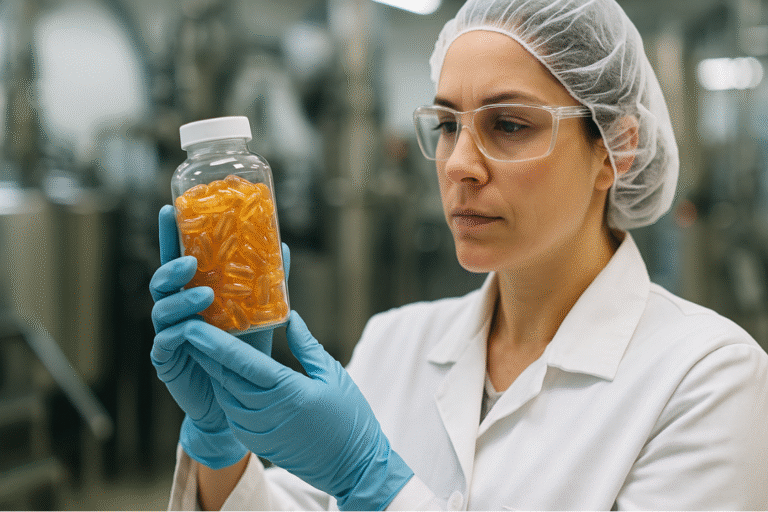Not every supplement manufacturer follows the same standards. The supplement industry covers many dietary supplements, including vitamins, amino acids, and herbal dietary ingredients, yet some companies fall short on quality assurance and good manufacturing practices. Knowing how to evaluate a supplement manufacturer helps protect your brand and align with regulatory expectations.
Because dietary supplements do not receive FDA approval before entering the market, each dietary supplement manufacturer is responsible for accurate product labeling, safety documentation, and consistent manufacturing processes. A structured review of five stages—Research, Communication, Facility, Logistics, and Agreement—helps you find partners that value transparency and compliance within the dietary supplement industry.
What Should You Check During Initial Research?
Initial research helps you avoid manufacturers who cut corners or operate without proper oversight. Evaluate their qualifications, ingredient sourcing policies, and certifications. Reputable supplement manufacturers publish clear information about their processes and maintain open contact with consumers and health care professionals.
All dietary supplement manufacturers must follow current good manufacturing practice (cGMP) regulations issued by the FDA. These rules establish minimum quality standards to ensure product identity, purity, and strength. Manufacturers must also document quality control procedures and use filtered, uncontaminated food ingredients and dietary substances. Under the Dietary Supplement Health and Education Act (DSHEA), any new dietary ingredients must be reported to the FDA at least 75 days before marketing.
Independent verification programs, including NSF International (National Sanitation Foundation), ConsumerLab.com, and USP (United States Pharmacopeia), assess the quality of products for label accuracy, declared potency, and the absence of harmful levels of heavy metals or other specified contaminants. These certifications help confirm that what’s listed on the label reflects what’s actually in the product.
How to Verify cGMP, FDA, and ISO Certifications
Confirming certification status reduces compliance and safety risks in supplement manufacturing. Ask for documentation that proves legitimate compliance with all relevant regulations.
- cGMP compliance: Mandatory since 2010 for all dietary supplement manufacturers; verifies adherence to written procedures, sanitation, and recordkeeping.
- FDA registration: The FDA registers and inspects facilities but does not issue “certifications.”
- ISO 9001 / ISO 22000: These international standards cover quality management and food safety in manufacturing environments.
- Third-party seals: Programs like NSF International and USP validate ingredient quality, product labeling, and production consistency.
A valid certificate should show the issuing body, scope, and expiration date. Certification seals may appear on product labels or promotional materials, but only if verification remains current.
How to Spot Red Flags in a Manufacturer’s Reputation Online
Public reputation gives early clues about compliance and integrity. When assessing how to evaluate a supplement manufacturer, look for transparency about sourcing, laboratory testing, and quality assurance.
Be cautious of:
- Repeated product recalls or unresolved adverse events
- Conflicting product claims or misleading promotional material
- Fake testimonials or manipulated reviews from consumers
- Lack of information about manufacturer specifications or ingredient sourcing
- Regulatory actions for mislabeling or violations of Federal Trade Commission rules
Reliable supplement manufacturers maintain open communication, documented corrective actions, and consistent compliance within the regulatory framework.

How to Communicate and Gather Early Insights
Effective communication helps confirm professionalism and regulatory compliance. Early discussions test responsiveness, documentation readiness, and flexibility. Supplement manufacturers who provide clear timelines, respond promptly, and explain their processes are more likely to maintain consistent quality products.
Transparent exchanges also support adherence to Federal Trade Commission and FDA labeling requirements related to dietary supplement advertising and product claims.
What Questions Should You Ask During Initial Calls?
Asking direct questions helps you assess production capability and reliability:
- Minimum order quantities, pricing tiers, and manufacturer specifications
- Procedures for ingredient sourcing and verification of food ingredients
- Experience producing amino acids, vitamins, or other key ingredients
- Approach to formulation development, dosage accuracy, and consultation with health care professionals
- Scalability and contingency plans for public health emergencies
- Policies for quality control, testing, and certifying organizations used for third-party audits
Avoid choosing based on price alone. A supplement manufacturer that underbids may compromise quality or increase safety risks.
How to Judge Responsiveness and Transparency
Responsiveness is one of the clearest indicators of dependability in supplement manufacturing. Observe how quickly they provide answers, how detailed those answers are, and whether they share official reports when requested.
Evaluate:
- Timely responses with actionable details
- Regular updates on project milestones
- Access to audits, certificates, and verification programs
- Transparent cost breakdowns and feasible lead times
- Willingness to arrange facility tours
Open and consistent communication supports ongoing regulatory compliance and helps prevent issues that could lead to serious adverse events or wrong one errors during production.

How to Evaluate a Facility’s Quality and Capacity
Touring a facility, either virtually or in person, provides insight into operational controls and adherence to good manufacturing practices. Observe cleanliness, organization, and how materials move through each phase of manufacturing.
A compliant dietary supplement manufacturer should maintain strong quality assurance across all departments. Internal audits, documented laboratory testing, and clear procedures for handling adverse events demonstrate accountability to both regulators and health care professionals.
What to Look for During a Virtual or On-Site Tour
During a walkthrough, take note of:
- Clean work zones and proper separation of dietary ingredients and conventional food materials
- Appropriate use of personal protective equipment and clear workflow signage
- Accessible documentation for training logs and manufacturing processes
- Evidence of sanitation, calibration, and batch segregation
The FDA’s Center for Food Safety and Applied Nutrition (CFSAN) oversees inspections to verify identity, purity, and composition. Organized documentation and visible discipline indicate a facility that values transparency and quality standards.
What a Proper Quality Control Process Should Include
Comprehensive quality control begins with raw material verification and ends with secure packaging. Review how each batch is tested and logged.
- Raw material verification and supplier audits
- In-process testing for blend consistency
- Final laboratory testing for potency and specified contaminants
- Maintenance of Certificates of Analysis verifying what’s listed on the label, including serving size and ingredients listed
Independent certifying organizations such as NSF International and USP offer additional assurance that product labels and label claims accurately reflect composition without guaranteeing consumer outcomes.

What About Packaging, Storage, and Shipping Logistics?
Packaging, storage, and transport influence food safety and compliance. Packaging must include a Supplement Facts panel, follow FDA labeling requirements, and protect dietary supplements from contamination and environmental damage.
Correct labeling ensures regulatory compliance and alignment with Federal Trade Commission policies for truthful promotional materials and advertising.
How to Confirm Packaging Compliance and Durability
Review all product labeling elements for accuracy:
- Include a supplement facts panel, serving size, and manufacturer contact information
- List all dietary ingredients, food ingredients, and key ingredients accurately
- Use certification seals only when verified through verification programs or certifying organizations
- Keep label claims consistent with allowed nutrient and structure-function language under FDA guidance
Packaging should protect against moisture, oxygen, and light exposure. Features such as tamper-evident seals and compression testing help ensure stability through distribution, though they do not guarantee safety or health benefits.
What Fulfillment and Storage Services Should Be Available
Reliable supplement manufacturers support fulfillment processes that meet traceability and regulatory compliance standards:
- Lot tracking, expiry monitoring, and returns handling
- Temperature-controlled storage between 15–25°C with humidity control
- Separation of allergens and documentation for public health emergencies
- Use of FEFO (First Expired, First Out) inventory methods for supplements and tablets
- Records for COAs and documentation of serious adverse events reported by a health care professional or other health care setting
Service Level Agreements (SLAs) and performance targets such as 98% on-time shipment or 99.5% inventory accuracy indicate strong internal control systems. Transparent pricing avoids hidden costs under limited resources.

Your Final Checklist for Evaluating a Supplement Manufacturer
Before signing an agreement, review all findings. Confirm FDA registration, cGMP compliance, and third-party certifications. Inspect facilities, confirm testing procedures, and ensure packaging follows FDA labeling requirements.
Your chosen dietary supplement manufacturer should demonstrate integrity in ingredient sourcing, maintain accurate product labeling, and document manufacturing processes that align with the regulatory framework. Reliable partnerships result in consistent quality products that comply with federal standards, not in implied cures or medical claims.
Frequently Asked Questions
What is the best way to vet a supplement manufacturer?
Review FDA registration, current good manufacturing practice audits, and verification programs, and evaluate supplier transparency and complaint history.
How can I confirm if a manufacturer follows cGMP standards?
Request audit reports, certificates from certifying organizations, and inspection outcomes that confirm adherence to good manufacturing practices.
What are common red flags in supplement manufacturing?
Multiple product recalls, vague sourcing data, inconsistent product labels, or unverified product claims may suggest non-compliance.
Should I visit the manufacturing facility before signing a contract?
Yes, virtual or on-site tours reveal real conditions and adherence to quality assurance systems and manufacturing processes.
How long does the evaluation process usually take?
Typical reviews of a supplement manufacturer take four to eight weeks, depending on documentation, testing, and response times.
References
- ConsumerLab.com. (n.d.). ConsumerLab.com. Retrieved from https://www.consumerlab.com/
- National Institutes of Health, Office of Dietary Supplements. (2023, January 4). Dietary supplements: What you need to know (Fact sheet for consumers). Retrieved from https://ods.od.nih.gov/factsheets/WYNTK-Consumer/
- NSF International. (n.d.). Supplement and vitamin certification. Retrieved from https://www.nsf.org/consumer-resources/articles/supplement-vitamin-certification
- U.S. Food and Drug Administration. (2024, February 21). Questions and answers on dietary supplements. Retrieved from https://www.fda.gov/food/information-consumers-using-dietary-supplements/questions-and-answers-dietary-supplements
- U.S. Food and Drug Administration. (2024, March 28). Structure/function claims. Retrieved from https://www.fda.gov/food/nutrition-food-labeling-and-critical-foods/structurefunction-claims
- U.S. Food and Drug Administration. (2025, January 21). Current Good Manufacturing Practice (CGMP) regulations. Retrieved from https://www.fda.gov/drugs/pharmaceutical-quality-resources/current-good-manufacturing-practice-cgmp-regulations
- U.S. Pharmacopeial Convention. (n.d.). USP Verified Mark. Retrieved from https://www.usp.org/verification-services/verified-mark
- World Health Organization. (2003). Guide to good storage practices for pharmaceuticals (Annex 9 of WHO Technical Report Series, No. 908). Retrieved from https://www.fda.gov.ph/wp-content/uploads/2021/03/World-Health-Organization-Good-Storage-Practices.pdf





